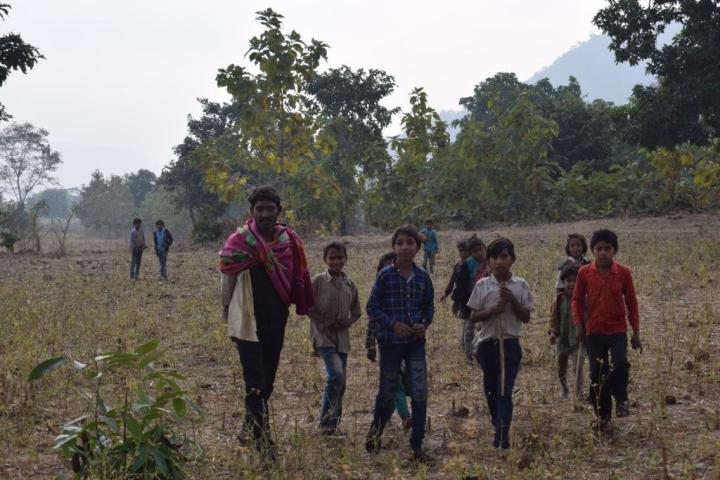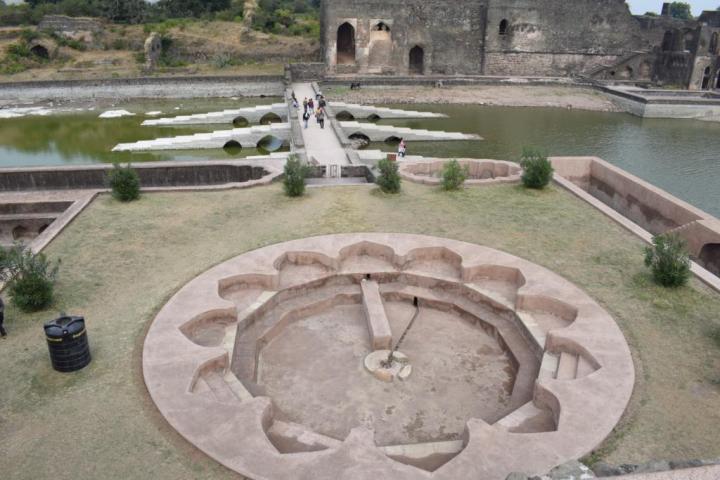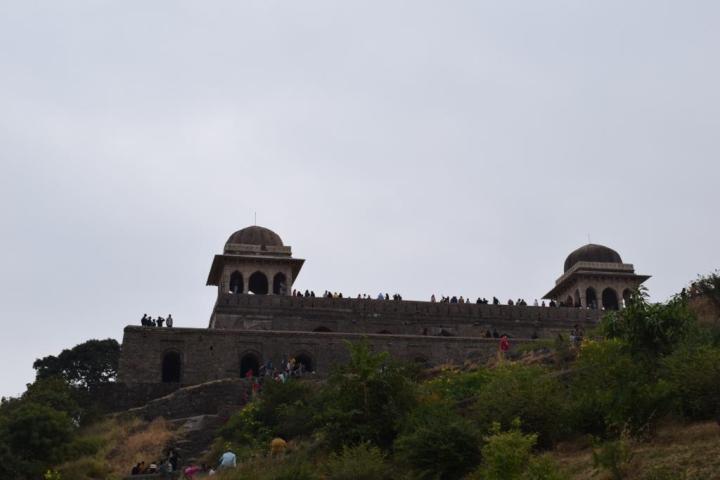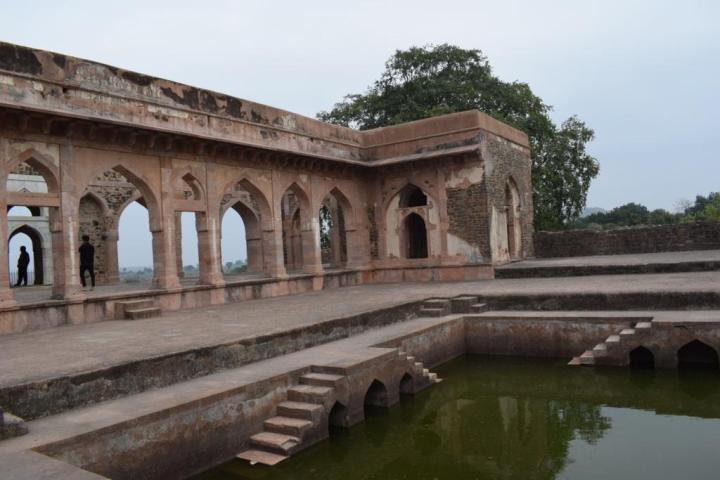The breeze in Mandu transports you to a magical land where reality disappears as the green place weaves a romantic spell

“Stop the balloon, we are tired now. Oh! Please, stop the balloon.” With a village dog in the lead, a dozen odd children were running on the rocky ground, trying to keep pace with the hot air balloon flying over their territory. The perfect sunrise was evading us —a group of eight with a German pilot —in a basket with a big umbrella that was taking us over little valleys, water bodies and ancient monuments. The clouds hid the sun. We could see straw rooftops. Men, women and children stopped their morning tasks, craned their necks to see this spaceship flying over the tribal belt of Mandu.
This was a morning of many ‘firsts’. This was the first time that they had seen a hot air balloon and it was the maiden flight of our pilot Andre over this terrain. It was also the first time that a week-long celebration, called Mandu Festival, was being held in this fort town. And thanks to this, it was the first time we were taking a hot air balloon ride in Madhya Pradesh. For the last 20 minutes, Andre had been trying to find a place to land. And for the last 15 minutes the excited group had been following us.

Finally, we were stationary on top of a hill, not allowed to jump out of the basket. Before the ground team could be intimated about our landing, the children reached us. No one huffed or puffed, they just stood, as we smiled and waved. Barefeet, unkempt hair and tattered clothes, they didn’t seem to feel the winter chill. Not a word came out, as I asked about school, mom, dad, nearest road, but the wide eyes and innocent giggles were a good beginning. Finally out of the basket after a few minutes, selfies done, the little ones were happy to show us the way down.
Like Mowgli from Jungle Book, they ran nimble- footed over the stones and the uneven muddy path. A young girl in black salwar and yellow kurta held my hand, as I tried to maintain balance over some rocks. Kiran pointed out her home as she didn’t understand Hindi very well. But we exchanged names and bid a happy farewell. The village was probably Budha Mandavgarh, but I didn’t ask. I had more reasons to be pleased. My driver for the past two days had been insisting that, “The tribals are difficult people and aggressive too.” I was glad that he had been proven wrong as these innocent smiles and helping hands were testimony to natives who are warm, trusting and joyful. Mandu is said to be home to the famous Bhils. However, we didn’t get to see their homes up close, as we had to head back to the campsite near Mandu Lake. We were staying in luxury tents, the area created for the festival.
While I was engaged in the fairly modern pursuit of hot air ballooning, Mandu’s allure lies in past —the romance of Rani Roopmati and Baz Bahadur — which was brought alive not so much by history books as by Amar Chitra Katha’s series on our folk tales which we devoured as children. Mandu won the Best Heritage City award in 2018 and one of the ways to experience the town is to witness the light and sound show, held every evening at Hindola Mahal, located in the royal complex.

This royal complex, in the heart of Mandu, comprises Jahaz Mahal, Royal Palace, Jal Mahal, Dilawar Khan’s Mosque, Nahar Jharokha, Gadashah Palace, flower-shaped baodis, talabs, taweli or stables and green landscaped gardens. These monuments stand testimony to a recorded era but the roots of Mandu have been traced to the sixth century.

A walk in the complex during the day had revealed the many ways people were in sync with Nature. Baodisor water structures were constructed in the shape of flowers and animals.

From the roof of the Jal Mahal, which now functions as a guest house, I saw a lotus-shaped structure. In the Jahaz Mahal there was a tortoise-shaped one while the Royal Palace has a Champa baodi. Jahaz Mahal, a narrow long building, constructed in the shape of a ship, housed the Sultan’s harem and is an architectural marvel.
History of Mandu
Going back to the 11th century, this fort town in Malwa region was ruled by the Paramaras. Historians say that King Jayavarman or his predecessor Jaitugi possibly moved the capital from Dhar to Mandu as the topography provided a natural defence against enemy attacks. Located at an elevation of 2,079 feet on the Vindhya mountain range, it extended for 13 km, overlooking the plateau of Malwa to the north and the valley of the Narmada River to the south.

The walls of the fort have crumbled but three gates are intact. The region came under Sultan of Delhi, Alauddin Khalji’s dominion in 1305. In 1401, Timur captured Delhi and the governor of Malwa, Dilawar Khan, established the Ghuri dynasty here. His son, Hoshang Shah, turned Mandu into a prosperous town.
Shah’s son Mohammed, third and last ruler of Ghuri dynasty, was poisoned by Mohammed Khalji who was succeeded by his son Ghiyas-ud-din in 1469. In turn, the 80-year-old king was poisoned by his son Nasir-ud-din. Battles continued.
The sixth Khalji ruler Mahmud II, lost the region to Bahadur Shah of Gujarat in 1531. At that time, Mughal emperor Humayun had succeeded Babur in Delhi. The emperor was warring with Sher Shah Suri when he learned of an attack by Bahadur Shah, assisted by the Portuguese. Humayun defeated Bahadur Shah and Mandu got a new ruler.
But Humayun lost to Mallu Khan, an officer of the Khalji dynasty.
Romance of Rani Roopmati & Baaz Bahadur
After a decade of battles, Baz Bahadur became the king of Malwa. And then began the saga of Rani Roopmati and Baz Bahadur.
The beautiful Rani Roopmati was a poet, born in a Brahmin family who lived about 25km away from Mandu. Roopmati, renowned for her melodious voice and beauty, attracted many suitors. Eventually her father married her to the king of Chanderi who sang well at the swayamvar.
Roopmati’s daily ritual began with the worship of river Narmada before which she would not eat. But the river did not flow past Chanderi. So the starving lady was brought back to her home town.
During this time, Baz Bahadur heard her singing and lost his heart to her. She agreed to come to the palace on the condition that she was allowed to worship the river daily. For this, Rewa Kund, a reservoir equipped with an aqueduct to supply Roopmati’s palace with water was constructed. A pavillion from where she could see the river was also made. But all good things come to an end.

The Mughal emperor Akbar heard about the beautiful lady and summoned her to his court in Delhi. Baz Bahadur refused and Akbar sent Adham Khan to capture Mandu and Roopmati. Baz Bahadur was defeated in the battle and fled. Mandu fell and Rani Roopmati poisoned herself, preferring death rather than submission to the enemy.
A new king
Later, the Maratha king Peshwa Baji Rao I became the ruler in 1732 and shifted the capital to Dhar again. With the transfer of power, the sloping walls of Hindola Mahal were barren once again. Built in the shape of a swing in motion, it was probably used as a hall during the reign of Ghiyas-Ud-Din (1469-1500).
Roots of Mandu
An inscription, dated 612 VS (555 CE), was discovered from Talanpur (around 100 km from Mandu). This states that Chandra Simha, a merchant, installed a statue in a Parshvanatha temple located in ‘Mandapa Durg’. The very word Mandu comes from Mandapa and Durg. In fact, the area is dotted with ruins.

Heart of Mandu
Earth has so much power to bear change, my mind ran as we headed to see the other monuments. Like the others, I was in a trance imagining the lovestruck couple as I climbed up to Rani Roopmati’s pavilion. The clouds hid the river but we saw Baz Bahadur’s palace. It was time for the evening arti at Rewa Kund which is considered sacred by pilgrims.

After exploring the world of Rani Roopmati, we headed to other monuments. “I am now taking you the first marble structure of this country. This was the inspiration for the Taj Mahal,” the guide said.

Soon, we were in front of Jami Masjid, the oldest mosque dating to 1405. Right behind this was the marble structure–Hoshang Shah’s tomb. But the most interesting monument, right in front of the Jami Masjid, was Asharfi Mahal. Legend says that the king gave the fat wives a gold coin for every step they climbed, urging them to lose weight. The ruins also house the tomb of Mahmud Khilji and a tower of victory.

Goodbye Mandu

All too soon, the mesmerising stay was coming to an end. But a sunset at the Lohani Caves was probably the best goodbye ever. The natural rock-cut caves are said to be home to Shiva devotees. Here, statues and carvings of Shiva, Parvati, Vishnu and Lakshmi were discovered. I was trapped in eternity. “People mostly come to Mandu for a day. But this festival brought the town alive,” a visitor said. “On any other day, I would have left by sunset with my family, but we are going to enjoy the evening concert. You must come in the monsoon. The clouds hang low and the area is all green.”
The magic continues…
More to see & do

DARYA KHAN’S TOMB COMPLEX: A minister in the court of Mahmud Khalji II, the complex has a mosque, pond and an inn.
HATHI PAGA MAHAL: The massive domed mahal is located on the southeastern side of the Darya Khan Complex.
SHRI MANDAVAGADH TEERTH: The temple, dedicated to Lord Suparshvanatha, belongs to the Shwetambar Jain sect. It was expanded in the 14th century. CHATURBHUJ SHRI RAMA TEMPLE: It was built by Maharani Sakarwar Bai in 1769 CE.
NEELKANTHA PALACE, a temple dedicated to Shiva, built by Emperor Akbar. o Caravan Sarai
MALIK MUGITH’S MOSQUE (father of Mahmud Khilji II), Dai ki Choti Behen ka Mahal
Maheshwar, where the famous Maheshwari saris are made, is about an hour’s drive from Mandu.
Bite into some Mandu ki imli, the fruit of the Baobab tree that is normally found in Madagascar.

Stay at the Mandu resort run by Madhya Pradesh tourism and enjoy boating in the lake.
How to Reach Mandu
The nearest city is Indore, about 100 km from Mandu. Indore is easily accessible by air, road and train and from there you can hire a cab for Mandu.

This blog post is part of #BlogchatterA2Z 2023 challenge.


How lovely to have flown over the villages in a hot air balloon. I wonder what the local children really thought when they saw it – curiosity, fear, excitement? It must have been quite daunting for Andre on his maiden voyage! It seems there are plenty of things to see back on the ground in Mandu.
LikeLiked by 1 person
It was exhilarating to fly over such terrain. We enjoyed the ride.
LikeLike
What a different way to explore this place from the 11th century than a hot air balloon ride. So memorable and would definitely add to the excitement of a day trip to visit this wonderfully ancient site.
LikeLiked by 1 person
How nice that you got your first glimpse of Mandu from a Hot Air Balloon. And great that you had enough time and a good guide to properly explore everything afterwards. It seems there are not so many tourists visiting this place.
LikeLiked by 1 person
It has .mostly local tourists who.come for a few hours but it’s an offbeat green space
LikeLike
I would definitely want to plan to do a hot air balloon ride over Mandu. And fun to have a group of children chasing you to your landing spot. And to have them guide you to the village. What an interesting history to read about the lovestruck couple. Sounds like a great visit through sunset.
LikeLiked by 1 person
And it’s a beautiful monsoon destination too.. 😁
LikeLike
Mandu in Madhya Pradesh is such a beautiful place shrouded in the mysticism of it’s historic past.The fortresses, lotus ponds, caves and arches delve in to the architectural elegance. Thank you for sharing the flashing history related to it which really makes this place legendary one.
LikeLiked by 1 person
I’ve never been on a hot balloon ride. It must be such a thrilling experience to see the wonders of nature from that perspective. If those monuments could talk, I’m sure there would be plenty of rich stories to tell. I love how the village people welcomed you with their innocence and joy.
LikeLike
What an incredible entrance you made to Mandu, a place filled with history, tradition, and stories of love and loss. I love how architectural elements of the Royal Place are in synch with nature, and that the first marble structure inspired the Taj Mahal. This is truly a place where knowing these stories and intimate details makes it all the more alluring.
LikeLike
I must admit, I have never been to Madhya Pradesh, even as an India! Never heard of Mandu or the Mandu festival, so it was an interesting read for me and quite a lesson in history!
LikeLiked by 1 person
Mandu has been evading me for a while. Every time I make a plan, something new comes up and I have to cancel it. The last one being 2020 where I had the tickets already. This virtual tour is like a salt to my wounds. I so want to visit the Roopmati mahal and relive the romance. And definitely try the hot air balloon here.
LikeLike